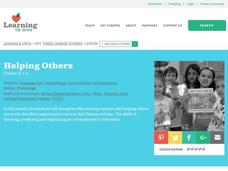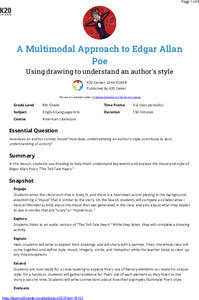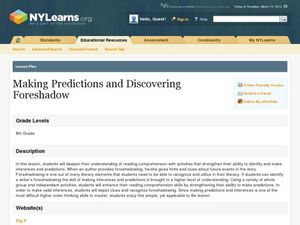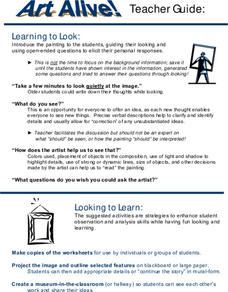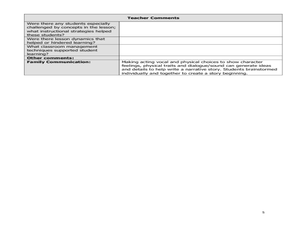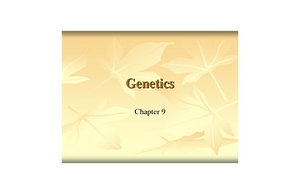Curated OER
Changing the Point of View
Fourth graders identify the point of view. In this point of view lesson students compare and contrast the point of view from third person omniscient and first person. Students rewrite a paragraph in an alternative point of view.
Curated OER
Changing Setting in a Story
Second graders explore how the setting in a story changes throughout. In this language arts lesson, 2nd graders read a story and identify the setting at various points within the story. Students describe the changes in setting.
Curated OER
The Little Prince (Chapters 1-4) by Antoine de Saint-Exupery
Students read Antoine de Saint-Exupery's The Little Prince and complete reading and vocabulary activities. In this reading and vocabulary lesson, students review vocabulary for the story and identify story elements for the text.
Curated OER
Identifying and Describing Story Elements
First graders examine how to identify the different elements of a story and how they fit in a definite sequence. The use of comprehension skills is essential to retell the story as desired within the lesson.
Curated OER
Trouble With Trolls
Young scholars listen to The Trouble With Trolls and discuss fables. In this story elements instructional activity, students work on reading skills. Young scholars participate in different reading activities.
Curated OER
Helping Others
Learners explore philanthropy. In this service learning lesson, students read The Seven Chinese Brothers, identify the elements of the story, and then go out in the world to help others by sharing their talents.
Curated OER
Seems Like a Million Bucks
Young scholars explore philanthropy. In this service learning lesson, students read Sam and the Lucky Moon, identify the elements of the story, and examine the benefits and costs of giving.
CC Homestead
Summarize
Designed for third graders but appropriate for older learners as well, this packet of materials underscores the necessity of teaching kids how to summarize, how to identify main ideas and supporting details, and how to ask questions...
K20 LEARN
A Multimodal Approach To Edgar Allan Poe Using Drawing To Understand An Author's Style
True! Poe's "The Tell-Tale Heart" makes readers nervous. But how? Young scholars create a drawing while listening to a reading of Poe's eerie tale to understand how writers create the mood of their stories and what their writing style...
Curated OER
Foreshadowing and Making Predictions
"What happens next?" Using real-life scenarios, movies, images, and other prompts, pupils practice making predictions based on inferences from clues. A SMART board activity takes them from making predictions to writing a prediction...
K20 LEARN
Active Or Passive?—"The Monkey's Paw": Grammar/Language Usage
Don't you wish you could use passive voice? Be careful what you wish for! "The Monkey's Paw" is the focus of a grammar and language usage instructional activity about active and passive voice. Readers identify examples of active and...
Memorial Art Gallery
Art Alive! - Towing a Boat, Honfleur
Color, light and shadow, the placement and size of objects. These are some of the tools artists used to tell their stories. Model for learners how to read a painting by closely examining these features. The richly detailed packet...
Curated OER
A Modest Proposal: Irony Made Understandable with Rock and Roll
Who doesn't love music? Poems and songs will engage your high school class in a discussion about irony. Use songs like "Rockin' in the Free World" or "Born in the U.S.A." to illustrate the ironic point of view. Print the lyrics so...
J. Paul Getty Trust
Still-Life Painting: Arranging Nature—Lesson 1
Art learners examine still-life arrangement images and respond to a series of prompts. In a whole-class discussion, pupils list elements and qualities that still-life paintings can have. After instructors create an arrangement and model...
Missouri Department of Elementary
The Clique
Mean girls and bully packs are favorite topic for films and TV shows that focus on the destructive power of cliques. High school freshmen are asked to reflect on both the positive and negative aspects of cliques by reading a short...
Literacy Design Collaborative
"Masque of the Red Death" - Symbolism and the Development of an Allegory
Analyze chunks of Masque of the Red Death to determine Edgar Allan Poe's use of symbolism and development of allegory. Readers learn new vocabulary words, answer comprehension questions, and identify symbols throughout the story....
Curated OER
Teaching Peace through Literature and Song
Negative effects of bullying come to light through listening to the book Thank You, Mr. Falker by Patricia Polacco. Class members identify philanthropic acts portrayed in the story and make illustrations to connect them to their own...
Curated OER
The Boy Who Cried Wolf
Second graders listen to the story, THE BOY WHO CRIED WOLF and in pairs, discuss the theme of the book and two things that they liked about it. They then read the book OOPS and discuss the theme of the book identifying the things they...
Curated OER
What If?
Second graders read WHAT IF? up to the page that ends "Suddenly, across the field they saw..." and discuss how the animals are feeling. They then discuss their feelings and in pairs discuss a possible ending to the story.
Curated OER
Acting as a Pre-write Tool
Second graders use acting to help them in a prewriting activity to develop a story. In this prewriting lesson plan, 2nd graders form a character map and brainstorm ideas for their story.
Curated OER
Five Parts That Contribute to the Whole
Students listen to and read an online story. Then they use a graphic organizer to learn the basic story elements. They select another online story and create a graphic organizer for its story elements.
Curated OER
Who, What, Where, When, Why, How
Students take a closer look at the organization of news stories. In this journalism lesson, students identify the elements of news stories and then write their news stories on the same topics using different types of leads.
Curated OER
Genetics
Students identify literary elements in each selection while learning about diversity and the struggle for equality in the United States. They use their knowledge to express the emotion and key literary elements in each piece through...
Curated OER
Journey to the Center of the Earth I
Students identify the elements of science fiction and write their own example. In this Journey to the Center of the Earth lesson students complete several activities about science fiction, authors and novels.





